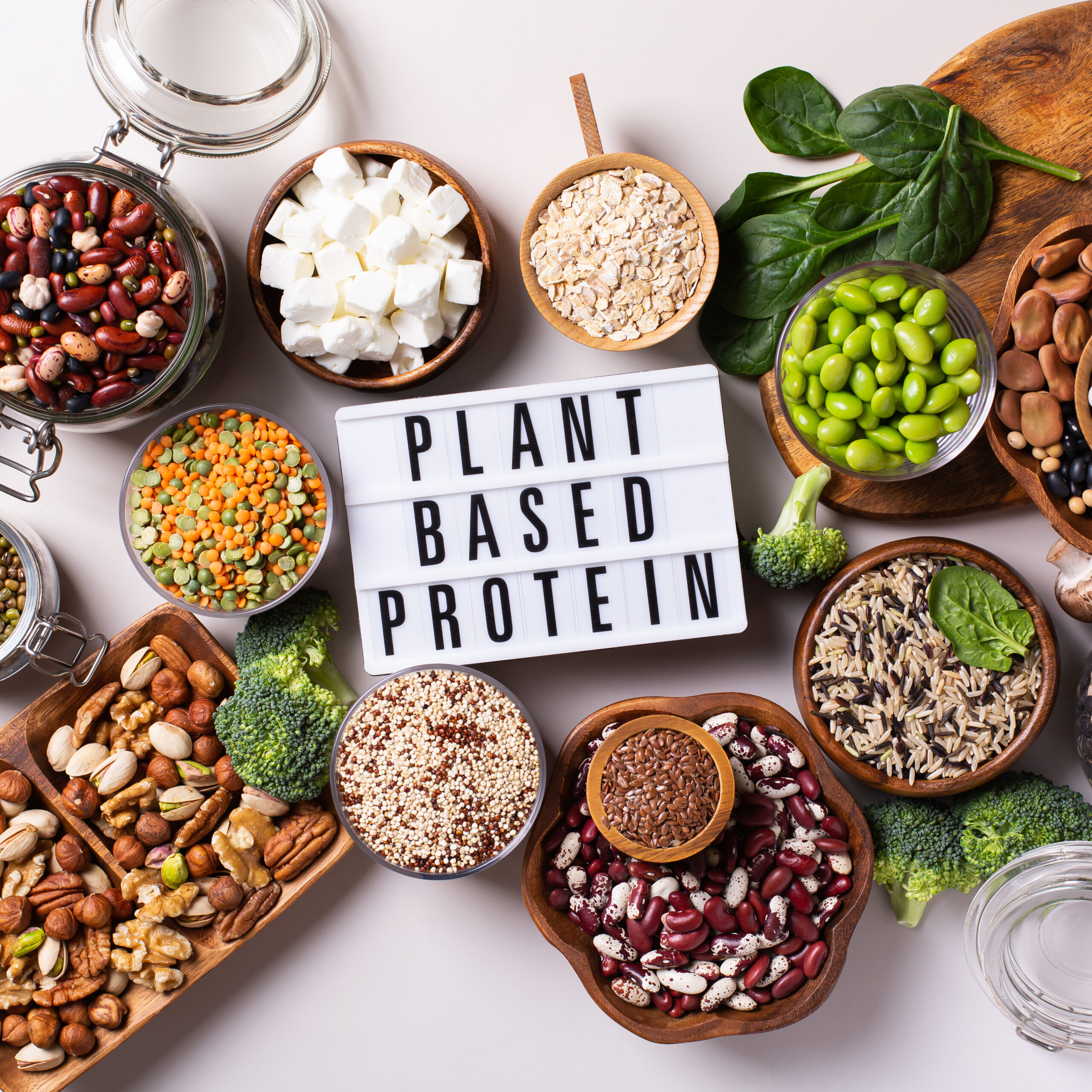
Meeting protein needs on a vegan diet is a common question and can be a nutritional concern for those wanting to shift to a plant-based eating approach.
Protein plays many roles in the body, such as growth, repair, and maintenance of the muscles, bones, and cells and supporting a healthy immune system.
We can get all the protein we need from plant foods – plus the health-promoting benefits of plant proteins, including dietary fiber, vitamins, minerals, antioxidants, lower saturated fat, and no dietary cholesterol.
Complementary Proteins Misconception
Proteins are made from 20 amino acids, also known as the “building blocks,” 9 of which are essential and must be obtained from food sources.
There’s a general misconception that plant foods are “incomplete” or lacking one or more essential amino acids, leading to the theory that eating a certain combination of plant foods at the same time, also known as protein complementing, creates a “complete” protein, or in other words, a meal containing all 9 essential amino acids.
For example, beans are lower in the essential amino acid methionine, and grains are lower in the essential amino acid lysine, so eating a meal containing beans and rice would be considered a “complete” meal.
However, present-day research has shown that this is not the case, as all plant proteins contain at least some of every essential amino acid, just in varying amounts, and the liver can store and pool together amino acids as needed.
Therefore, it’s not necessary to eat a combination of plant foods at the same meal; instead, we can ensure we get all the protein we need on a vegan diet by eating protein-rich plant foods throughout the day and getting adequate daily calories.
Protein-Packed Plant Foods
Plant proteins include legumes, whole grains, nuts, seeds, and vegetables, offering practical ways to incorporate plant-rich protein into many meals and snacks.
Legumes (beans, peas, lentils, and soyfoods) are particularly nutritious due to their high protein and lysine content. Lysine is an essential amino acid often found in lower amounts in other plant foods.
Vegan nutrition experts and authors of Vegan for Life, Virginia Messina, MPH, RD, and Jack Norris, RD, recommend including at least three servings of legumes per day in their Vegan for Life Food Guide.
Examples of Legume Serving Sizes:
- ½ cup tofu or tempeh
- 3 oz plant-based meat
- ¼ cup peanuts or soynuts, or 2 Tbsp peanut butter
- 1 cup soy or pea protein milk
- ½ cup cooked beans
Protein Recommendations
There are a couple of ways to calculate our estimated protein needs:
One way is the Recommended Dietary Allowance (RDA) for protein for adults, which is 0.8 grams of protein per kilogram of body weight.
Vegan nutrition experts generally recommend a slightly higher protein intake for vegans, of 0.9 grams of protein per kilogram of body weight, to account for the lower digestibility of whole plant foods.
For example, an individual weighing 170 pounds would have an approximate protein need of 70 grams per day.
(To calculate body weight in kilograms, divide weight in pounds by 2.2 and multiply that number by 0.9 grams.)
Another method for estimating adult protein needs is through the Acceptable Macronutrient Distribution Range (AMDR), established by the National Academy of Sciences, which recommends that 10-35% of total daily calories come from protein.
For example, 10% of protein for an individual consuming 2,000 calories per day would generally need 50 grams of protein daily. (Protein contains 4 calories per gram.)
Of course, many factors play a role in an individual’s protein requirements, such as activity level, life stage, and medical conditions.
Additionally, counting each gram of protein eaten throughout the day can be a tedious task and not necessary to do when we’re eating a variety of plant proteins and getting enough calories each day.
Approximate Protein Content of Select Plant Foods
- 3 ounces of *firm tofu – 9 grams of protein
- 2 Tablespoons of peanut butter – 7 grams of protein
- ½ cup cooked black beans – 7 grams of protein
- 1 cup cooked whole-wheat spaghetti – 7 grams of protein
- ½ cup cooked frozen green peas – 4 grams of protein
- 1 cup of cooked quinoa – 8 grams of protein
(*Generally, the firmer the tofu, the higher the protein content.)
Nutrient Values are based from the source USDA FoodData Central.
Nutritional Perspective on Plant-Based Meats
Many plant-based meat options are available on the market, from vegan burgers, chicken, deli slices, hot dogs, sausages, ground beef, seafood, and more.
Plant proteins commonly used in vegan meats are wheat, soy, and pea protein-based. However, innovative plant proteins, such as fungi-based (mycoprotein), mung protein, and potato protein, are growing.
Plant-based meats can often be referred to as “transitional foods” for someone first shifting to eating plant proteins, as food science has made it possible to mimic the appearance, taste, and texture of animal-based meat.
Regardless of how long someone has been on their plant-based journey, incorporating vegan meats, especially choosing lower saturated fat options more often, can be a convenient and creative way to switch up meal planning and boost protein intake.
Take-Home Message
Many plant foods are packed with protein, making it simple to meet our daily protein needs on a vegan diet while contributing to our overall health and well-being.
If you’re looking for nutritional guidance and support on your plant-based journey, please feel free to reach out to schedule a free 20-minute discovery call here!
References
Merck Manuals. (n.d.). Overview of proteins [Video]. Merck Manuals Professional Edition. https://www.merckmanuals.com/professional/multimedia/video/v57361704
Mangels, R., Messina, V., & Messina, M. (2021). The Dietitian’s Guide to Vegetarian Diets: Issues and Applications. Jones & Bartlett Learning.
Norris, J., & Messina, V. (2020). Vegan for Life: Everything You Need to Know to Be Healthy on a Plant-based Diet (Second Edition). Hachette Go.
Protein and Amino Acids. (2023, March). VeganHealth.org. https://veganhealth.org/protein/
Wolfe, R. R., Cifelli, A. M., Kostas, G., & Kim, I. (2017). Optimizing Protein Intake in Adults: Interpretation and Application of the Recommended Dietary Allowance Compared with the Acceptable Macronutrient Distribution Range. Advances in Nutrition, 8(2), 266–275. https://doi.org/10.3945/an.116.013821
Langyan, S., Yadava, P., Khan, F. N., Dar, Z. A., Singh, R., & Kumar, A. (2022). Sustaining Protein Nutrition Through Plant-Based Foods. Frontiers in Nutrition, 8. https://doi.org/10.3389/fnut.2021.772573
FoodData Central. (n.d.). https://fdc.nal.usda.gov/index.html
Disclaimer: This blog post is provided for informational and educational purposes only and should never be relied upon in any way as medical or mental health advice. Always consult your physician or other qualified healthcare provider for any health-related questions and concerns or before implementing anything you may learn through this blog post.
(Please note that external links open in a new window)

